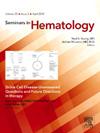Biological heterogeneity in diffuse large B-cell lymphoma
IF 5
3区 医学
Q1 HEMATOLOGY
引用次数: 0
Abstract
Diffuse large B-cell lymphoma (DLBCL) is heterogeneous both in clinical outcomes and the underlying disease biology. Over the last 2 decades, several different approaches for dissecting biological heterogeneity have emerged. Gene expression profiling (GEP) stratifies DLBCL into 3 broad groups (ABC, GCB, and DZsig/MHG), each with parallels to different normal mature B cell developmental states and prognostic implications. More recently, several different genomic approaches have been developed to categorize DLBCL based on the co-occurrence of tumor somatic mutations, identifying more granular biologically unified subgroups that complement GEP-based approaches. We review the molecular approaches and clinical evidence supporting the stratification of DLBCL patients based on tumor biology. By offering a platform for subtype-guided therapy, these divisions remain a promising avenue for improving patient outcomes, especially in subgroups with inferior outcomes with current standard-of-care therapy.
弥漫大b细胞淋巴瘤的生物学异质性
弥漫性大b细胞淋巴瘤(DLBCL)在临床结果和潜在疾病生物学上都是异质性的。在过去的二十年里,出现了几种不同的方法来解剖生物异质性。基因表达谱(GEP)将DLBCL分为三大类(ABC、GCB和DZsig/MHG),每一类都与不同的正常成熟B细胞发育状态和预后相关。最近,几种不同的基因组方法被开发出来,根据肿瘤体细胞突变的共同发生对DLBCL进行分类,确定了更细粒度的生物学统一亚群,补充了基于gep的方法。我们回顾了基于肿瘤生物学的DLBCL患者分层的分子方法和临床证据。通过提供一个亚型引导治疗的平台,这些分类仍然是改善患者预后的有希望的途径,特别是在目前标准治疗结果较差的亚组中。
本文章由计算机程序翻译,如有差异,请以英文原文为准。
求助全文
约1分钟内获得全文
求助全文
来源期刊

Seminars in hematology
医学-血液学
CiteScore
6.20
自引率
2.80%
发文量
30
审稿时长
35 days
期刊介绍:
Seminars in Hematology aims to present subjects of current importance in clinical hematology, including related areas of oncology, hematopathology, and blood banking. The journal''s unique issue structure allows for a multi-faceted overview of a single topic via a curated selection of review articles, while also offering a variety of articles that present dynamic and front-line material immediately influencing the field. Seminars in Hematology is devoted to making the important and current work accessible, comprehensible, and valuable to the practicing physician, young investigator, clinical practitioners, and internists/paediatricians with strong interests in blood diseases. Seminars in Hematology publishes original research, reviews, short communications and mini- reviews.
 求助内容:
求助内容: 应助结果提醒方式:
应助结果提醒方式:


